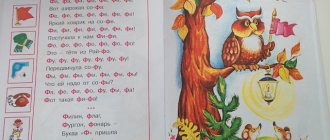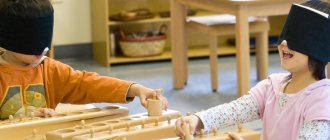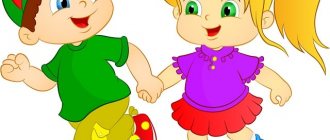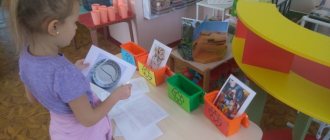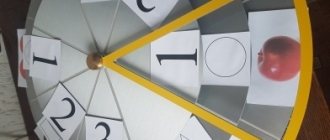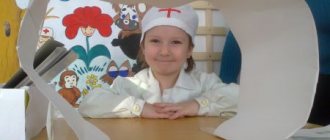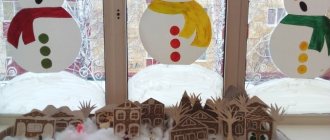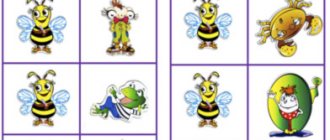According to M. Montessori, the most important task between the ages of 0 and 3 years is sensory development. During this period, children explore the world using various senses, and the main sources of information are vision and tactile perception. In order for the baby to actively develop, parents must create an environment for the child in which he could receive new and vivid sensory experiences. Sensory boxes will help make the learning environment at home even more enriched. What to fill a baby's sensory box with? How to play with her? At what age can you start playing games like this? We will answer these and other questions in this article.
What is a sensory box?
Sensory boxes are containers with various sensory fillings (liquids, bulk materials, jelly, paste, toys, etc.). This is an extremely useful and multifunctional toy for children of early and preschool age. The baby can feel small objects, pour them in, hide them, and come up with his own story. Playing with a sensory box helps develop a child's fine motor skills, attention, imagination and speech.
It is easy to make a sensory box for a child with your own hands with minimal material costs.
This educational toy can be based on any container: box, container, basin, pan. The main thing is that the child feels comfortable playing with it. Next, the container is filled with various materials (depending on the theme of the sensory box and the age of the child). Usually these are cereals, pasta, pebbles, natural materials, water, jelly, cotton wool, etc. To make it more interesting for your baby, put small toys and tools (shovels and scoops) in the “box”.
Card index of games on sensory development for the 2nd junior group
Didactic games can be combined with fine arts lessons. It is not necessary to study according to templates, since the production of the material can be entrusted to children. We must not forget that children's play should remain light and relaxed.
Note! It is necessary to exclude situations where entertainment turns into exercise, otherwise it can cause rejection in children.
"Nuts in the Nest"
Goal: development of fine motor skills of the hands, exercise for fixing colors.
Materials: egg carton, paints, brushes, jar of water, peeled walnuts.
Progress: the child makes a house for nuts. Each compartment in the egg carton is painted a different color. Then the nuts are decorated. The next task is to move the nut to the appropriate house.
"Palms"
Goal: develop the ability to find a pair, correlate colors, patterns and sizes.
Materials: cut out palms of different shapes and sizes. They should be multi-colored and patterned.
Progress: the child must arrange all his palms in pairs.
"Magic bag"
Goal: to develop the ability to determine the shape of objects by touch.
Materials: bag, small cubes, balls and other shapes, maybe flat, cut out of cardboard.
Progress: the teacher names the form, and the student quickly pulls it out of the bag.
"Build a Truck"
Goal: consolidation of knowledge about the shape and size of an object.
Materials: cardboard and scissors.
Progress: at the beginning of the lesson, children cut out the required number of shapes, from which they will then need to fold a truck (two circles, a rectangle and a square). The teacher shows how they can be folded into a vehicle, and the children repeat. The figures can be glued onto cardboard and then decorated.
Filling sensory boxes
The following can be used as the main filler for the sensory box:
- Cereals (rice, peas, millet, lentils, beans, buckwheat, semolina, etc.);
- Coffee;
- Pasta;
- Stones;
- Shells;
- Sand;
- Nuts;
- Cones;
- Dry leaves;
- Jelly;
- Water;
- Snow;
- Yarn;
- Textile;
- Vatu;
- Decorative stones for aquariums.
The more different sensations your baby gets, the more benefits for his development. Try to regularly change the contents of the sensory box to keep your child interested in playing with it.
Additional items:
- Animal figurines;
- Small toys;
- Constructor;
- Cubes;
- Letters and numbers.
Tools for playing in the sensory box:
- Bowls;
- Glasses;
- Spoons;
- Scoops;
- Rake;
- Tweezers;
- Magnifier;
- Funnel;
- Sieve.
Games with clothespins
Clothespins are an accessible material for developing fine motor skills. To attach or unhook a clothespin, the child uses his fingers and practices exciting movements. Children under 2 years old use their entire hand to grasp, and games with clothespins will help coordinate the precise work of their fingers. Thanks to the color scheme of clothespins, you can study colors and form mathematical concepts.
Using your imagination, you can offer your child many options for games with clothespins, including:
- Wash. Stretch a rope between two chairs and offer to hang the doll's clothes on it, securing with clothespins.
- Constructor. Using clothespins, three-dimensional figures, robots, animals, and vehicles are created.
- In the animal world. Print figurines of hedgehogs and bunnies. Attach needles in the form of clothespins to the hedgehog, and make ears out of them for the bunny.
- Polyanka. Cut out the sun, cloud, grass, tree from colored cardboard. The child attaches clothespins of the appropriate color to the stencil to create a three-dimensional picture.
- Who eats what? Print out the faces of different animals and the food they prefer. Cut a circle out of cardboard and divide it into sectors. Stick a picture of food on each one. Glue the faces onto the clothespins with tape. The child attaches clothespins with animals to the sector where suitable food is depicted.
Options for sensory boxes for children from 6 months
You can start playing with the sensory box as soon as your baby learns to sit. It is best to fill a sensory box for your baby with large and non-traumatic materials, for example, fabric, ribbons, pompoms, balls, sponges, cubes. You can also supplement it with various musical toys (bells, rattles) and something rustling (polyethylene, parchment paper).
If your baby is still small, use larger objects to fill the sensory box and carefully monitor how he plays.
For children over one and a half years old, you can use sensory boxes with cereals. At an early age, interest in small objects is especially great. Your baby will be happy to find hidden objects in the cereal. They can later be sorted by color or shape. In addition, playing with a sensory box can become training for instrumental actions: the ability to hold a spoon, pouring, and so on.
To make the filling of the sensory box brighter, you can color the rice at home. To do this, add a few drops of food coloring and 1 tablespoon of alcohol to a bag of rice (this is needed to fix the paint; the alcohol will evaporate quickly). Seal the bag tightly and stir to distribute the color evenly throughout the rice. Open the bag and wait for the cereal to dry.
If you and your child are learning the names of colors, then colored sensory boxes can be a good tool for practicing. Place different items of the same color into a container. When playing with such single-color sensory material, the baby will quickly remember the desired color.
The use of various tools and tools allows you to diversify games with the sensory box. Invite your child to play with the sieve and sift the semolina. To make it more interesting, hide small toys, pebbles or larger grains in the cereal. Using a sieve, the child must separate them from the semolina. With the help of such a game you can quickly master the concepts of “big” and “small”.
Sensory boxes filled with water cause genuine delight among children. With the help of a sieve and spoons, the baby can remove floating and sinking objects from the water, pour water into glasses, and make boats from molds and other available materials. You can add a little paint to the water - this will make playing even more fun and interesting.
Preschool children (over 3 years old) will be interested in themed sensory boxes. With their help, the child will learn new things about the world around him in a playful way. Such games are also very useful for the baby because they perfectly develop memory, attention, thinking and imagination. Here are some examples of themed sensory boxes:
- "Space"
- "Zoo"
- "Farm"
- "North Pole"
- "Construction"
Card index: sensory games for the middle group
It is assumed that children already have basic knowledge of shape, color and size. Therefore, sensory classes in the middle group can require a lot of time, and can also be combined, that is, aimed at developing several skills at once.
Note! The same games can be used in the older group.
"Coins"
Goal: to consolidate knowledge about the circle, to teach how to determine the size of objects by eye.
Materials: paper cups with holes in the bottom, coins of different sizes.
Procedure: first, the teacher cuts out a circle at the bottom of each cup that would correspond to one coin. The child matches objects with prepared holes. The teacher makes sure that smaller coins do not fit into the larger holes.
Other forms can also be correlated
"Cinderella"
Goal: development of fine motor skills of the hands.
Materials: various cereals (rice, buckwheat, peas).
Procedure: a small amount of all the cereals is poured onto a plate, and the children must sort them into cups at speed.
Didactic games can be of great help to the teacher in the process of children's sensory development.
Note! It is important to be able to choose the right material that would reflect the program objectives.
Also, we must not forget about the principle of moving from simple to complex and regular repetition. Every child in the kindergarten must actively participate in the process, and the game itself, at any level of difficulty, must maintain a dynamic pace.
Editor: Elizaveta Sergeevna Koneva
Primary school teacher of the first qualification category, defectologist.
Tips for successful work
Before you begin your chosen work, you should listen to the following tips:
- Prepare all required materials in advance.
- Scissors for children should first of all be safe, so they are suitable only with rounded ends.
- Consider protecting your work surface. It is better to cover it with oilcloth, and put special plastic boards for modeling.
- When painting with paints, you should make sure that the water is not very cloudy. After completing the drawing, it is good to cover the paints to prevent them from drying out, and wash your hands well.
- When sculpting, if there is no goal to dry the material, you need to wrap it in a suitable material: clay - in a piece of damp cloth, plasticine - in plain paper.
- Markers should be stored with their caps tightly closed.
- It is good to sharpen pencils with a sharpener.
DIY didactic games
Didactic educational games do not have to be purchased in a specialized store. You can create them yourself and involve your child in the process. This will make him want to learn new things while playing. Household items that a person encounters every day are suitable as equipment. This will introduce the preschooler to everyday objects and avoid additional cash expenses.
Finger dry pool
Dry pool is a game for the development of fine motor skills, which includes finger gymnastics. Fill a deep bowl 12-15 cm high halfway with dry peas. The child dips his hands into the filler, sorts out the peas, and scatters them. In this way, self-massage of the fingers occurs.
Games in a dry pool are accompanied by music or poetry. You can put small toys at the bottom of the bowl, which you need to find and describe with your eyes closed. The game is suitable for children two to three years old.
Salt dough beads game
Children are invited to create beads as a gift for their mother from multi-colored rings. The teacher makes salt dough rings in advance and dries them in the oven. You can buy the dough at the store or make it yourself. For this you will need:
- flour - 1 glass;
- salt - 1 glass;
- starch - 1 tbsp. l.;
- water - 1 ½ cups;
- colored gouache.
Dilute starch in ½ glass of cold water, pour 1 glass of boiling water. Mix half a glass of the resulting solution with flour and salt. Knead the dough, paint it in different colors. Form rings.
During the lesson, children string beads onto a cord and form a decoration.
Guide “put the eggs in your houses”
The teacher paints a cardboard container for eggs in 4 colors: red, blue, green, yellow. Boxes of chocolate eggs (kinder surprise) are covered with appropriate colored paper. Children place colorful eggs into the appropriate cells.
"Tactile Box"
The basis of the interactive manual is a box, a saucepan, and a plastic container with a lid. It is filled with natural materials (cereals, sand, flour, shells, stones, leaves). You can add paper, cotton wool, fabric, toys to the box. The box is supplemented with tools - a spoon, spatula, glasses, muffin tins. The child studies the contents of the box, learns to manipulate different objects, and becomes familiar with various tactile sensations. You can play with the contents of the box according to the instructions of an adult or leave room for the free creativity of a preschooler.
Game "colorful sticks"
Colored counting sticks - Cuisenaire's manual. It is a set of 116 plastic sticks in 10 different colors and sizes. The smallest stick is 10 mm long, the next ones increase by 10 mm. Sticks of the same length are colored the same. Using the manual allows children to develop their understanding of numbers based on counting and measurement, form spatial concepts, and study the “more-less” relationship. You can make your own sticks or buy them at the store.
Wonderful pouch
To play you will need a large thick fabric bag and various small objects: pebbles, figures, balls and beads, coins, fabric, cones. During the game, tactile perception develops. Children take turns putting their hand into the bag and describing the object they felt. The task is to guess what item is in the bag. The lesson is carried out both individually and in a group in kindergarten.
Constructor
Construction is an activity that is aimed at creating new objects from small parts. By assembling the details of the construction set, the child develops imagination, fine motor skills, thinking, and studies colors and shapes.
An adult can offer to assemble a figure according to a model, give an oral task, or allow the child to experiment.
"Spider in the Clearing"
To play, you will need a plastic transparent bucket with a lid; holes are made in it for lacing and attaching additional parts. A spider is glued to a lid made of colored paper. The eyes are made from plastic bottle caps, painted in suitable colors, and connected to the base. Laces are added to the paws and inserted into the holes. From them the child “weaves a web.”
Small objects and ribbons are placed in the bucket, which can be pushed through holes of different diameters. There are many options for manipulating the manual, so children will come up with a new game with the spider every time.
Sources:
https://www.maam.ru/detskijsad/didakticheskie-igry-po-sensorike-sdelanye-svoimi-rukami.html https://vospitanie.guru/doshkolniki/didakticheskie-igry-po-sensornomu-vospitaniyu https:// infourok.ru/sbornik-didakticheskih-igr-po-sensorike-1247589.html https://gotovluskshkole.ru/igry/igry-dlya-sensornogo-razvitiya-detej-2-3-let
